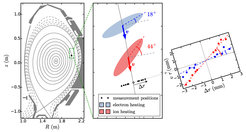Measurement of the tilt angle of turbulent structures with Doppler reflectometry
Measurements of turbulent density fluctuations are important to better understand transport in fusion plasmas. Characteristic for the structures are their tilt with respect to the radial direction. The tilt angle is predicted by theories and gyrokinetic simulations and depends on the dominant micro-instability and on the interaction of turbulence and plasma flows.
A new method for measuring the tilt angle of turbulent structures has been developed. As shown in the figure, it is based on the correlation of two Doppler reflectometry channels probing at radially displaced (Δr) positions. The time delay (τ) between the reflectometer signals provides a measurement of the tilt angle in the confined region of fusion plasmas.

The method has been applied on the ASDEX Upgrade tokamak. A change of the tilt angle has been measured between plasmas with either dominant ion or dominant electron heating. The trend is consistent with linear gyrokinetic simulations when moving from an ITG to a TEM dominated turbulence. Non-linear simulations are currently being performed, which will allow for quantitative comparisons. The method was also applied at the TJ-II stellarator.
For this work, Javier Pinzón received his joint doctorate (FUSION-DC) from the Technische Universität München and the Universidad Carlos III de Madrid on the 17th of July 2018.
Moreover this work was awarded with the “PhD poster prize” at the 45th European Physical Society (EPS) conference.
